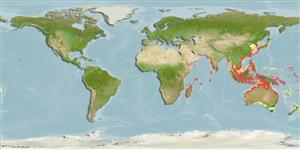Common names from other countries
Environment: milieu / climate zone / depth range / distribution range
पारिस्थितिकी
समुद्री ड़िमरसल; गहराई सीमा ? - 70 m (Ref. 39597). Tropical
Indo-West Pacific: southern India to southern China and New Caledonia.
आकार / वज़न / Age
Maturity: Lm ? range ? - ? cm
Max length : 13.0 cm TL पुल्लिंग / अलिंग; (Ref. 48635)
पृष्ठीय रीढ़ (सम्पूर्ण) : 12 - 15; पृष्ठीय सौफट रेज़ (सम्पूर्ण) : 7 - 8; गुदा कांटा: 2; ऐनल सौफट रेज़: 5. Geographical differences: specimens from the Gulf of Thailand usually with large blotches over the body; those from Indonesia and Australia generally have less solid markings. Species observed to alter its color from light to dark in captivity. Scales in vertical rows, 44-66 (Ref. 39597).
Found inshore on and around corals and hard bottoms (Ref. 39597), silty and muddy habitats (Ref. 48635). Often taken by nets and handlines (Ref. 39597). Also found in rocky bottoms and coral reef crevices in about 7-70 m (Ref 90102).
Life cycle and mating behavior
Maturities | पुनरुत्पत्ति | Spawnings | Egg(s) | Fecundities | लार्वा
Paxton, J.R., D.F. Hoese, G.R. Allen and J.E. Hanley, 1989. Pisces. Petromyzontidae to Carangidae. Zoological Catalogue of Australia, Vol. 7. Australian Government Publishing Service, Canberra, 665 p. (Ref. 7300)
IUCN Red List Status (Ref. 130435)
CITES (Ref. 128078)
Not Evaluated
Human uses
मात्स्यिकी: कोई रुचि बग़ैर; जलजीवालय: व्यापारिक
साधन
Special reports
Download XML
इंटरनेट स्रोत
Estimates based on models
Preferred temperature (Ref.
115969): 24.4 - 29.1, mean 28.1 (based on 1516 cells).
Phylogenetic diversity index (Ref.
82804): PD
50 = 0.5625 [Uniqueness, from 0.5 = low to 2.0 = high].
Bayesian length-weight: a=0.02399 (0.01270 - 0.04533), b=2.95 (2.78 - 3.12), in cm Total Length, based on LWR estimates for this species & (Sub)family-body (Ref.
93245).
Trophic level (Ref.
69278): 3.2 ±0.3 se; based on size and trophs of closest relatives
लौटाव (Ref.
120179): माध्यम, न्यूनतम जनसंख्या दुगनी होने का समय 1.4 - 4.4 वर्ष। (Preliminary K or Fecundity.).
Fishing Vulnerability (Ref.
59153): Low vulnerability (10 of 100).
